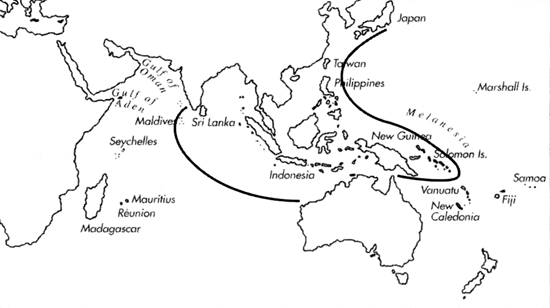Range: Maldives to W. Australia; Ryukyu Is. and Taiwan to Solomon Is. and Papua New Guinea.
Description: Medium-sized to moderately large, moderately solid to solid. Last whorl conical; outline almost straight, slightly convex adapically in small specimens. Shoulder angulate to broadly carinate, often outwardly curved producing a concave outline at subshoulder area. Spire of low to moderate height, outline concave to slightly sigmoid; apex may project from an otherwise almost flat spire. Larval shell of 2-2.25 whorls, maximum diameter 0.9-1 mm. First 4-6 postnuclear whorls weakly tuberculate. Teleoconch sutural ramps flat to slightly concave, with 1-2 increasing to 4-5 spiral grooves, obsolete in late whorls. Last whorl with a few spiral ribs at base.
| Shell Morphometry | ||
|---|---|---|
| L | 40-72 mm | |
| RW | 0.14-0.34 g/mm | |
| (L 40-63 mm) | ||
| RD | 0.51-0.65 | |
| PMD | 0.88-0.98 | |
| RSH | 0.04-0.17 | |
Ground colour white, yellow, orange or pale violet. Last whorl with a broad, continuous to sometimes interrupted, yellow or orange to brown spiral band on each side of centre, sometimes extending to shoulder and base. Long light to dark brown axial streaks may extend from shoulder ramp to base; most are interrupted centrally, producing blotches at both edges or only at the upper edge of the central area. Dotted to continuous spiral lines may cover entire last whorl, but vary in number and arrangement. Shells with no axial streaks or spiral lines occur. Larval whorls white to beige. Early teleoconch sutural ramps immaculate, often light pink; late ramps either of immaculate ground colour or more frequently with orange to dark brown radial markings. Aperture white, yellow, orange or violet.
Periostracum light olive, rather thin, translucent to opaque, with fine axial and widely spaced tufted spiral ridges on last whorl including shoulder.
Habitat and Habits: Intertidal to about 100 m.
Discussion: C. voluminalis resembles C. recluzianus, C. sukhadwalai, C. shikamai, C. bayani, and C. capreolus. C. capreolus is of lighter weight (RW 0.19-0.22), has a generally higher spire (RSH 0.13-0.19) with carinate late whorls, and its last whorl pattern lacks all the spiral elements that characterize C. voluminalis. C. bayani is best distinguished by its taller, narrower and pure white conoid early postnuclear whorls. In addition, its larval shell is brown, its early teleoconch whorls are more strongly tuberculate, and its shoulder is generally more sharply carinate. In C. bayani, the last whorl colour pattern is of predominantly brown markings, rather than the predominantly yellow to orange spiral bands of C. voluminalis. The periostracum of C. bayani is untufted. C. sukhadwalai has usually a lower spire (RSH 0.01-0.07), a more convex last whorl and a light orange larval shell; its early postnuclear whorls are smooth and the spiral sculpture of its late sutural ramps is more prominent. C. shikarnai differs in its undulate to tuberculate shoulder, multispiral brown larval shell (3-3.5 vs. 2-2.25 whorls) and fewer tuberculate spire whorls; its last whorl is generally narrower (RD 0.49-0.53) and its spire somewhat lower (RSH 0.04-0.08). C. recluzianus can be separated by its undulate to prominently tuberculate shoulder, brown multispiral larval she11 (3-3.25 whorls), very small number of tuberculate early postnuclear whorls (1.5 vs. 4-6), and by the distinct spiral grooves on its later sutural ramps; its spire is generally lower (RSH 0.02- 0.10). The whereabouts of the type(s) of C. voluminalis are unknown. However, specimens from W. Thailand (Pl. 30, Fig. 2), closely resemble the original figure in Reeve (Pl. 30, Fig. 1). The original descriptions of C. voluminalis and C. macarae as well as the holotype of C. macarae (Pl. 30, Fig. 3) correspond to the description of C. voluminalis we have given above, although the spiral grooves on sutural ramps, mentioned by Reeve for C. volurninalii, are obsolete on late ramps. We therefore agree with Walls, [I979] in synonymizing C. macarae with C. voluminalis. C.filicinctus (Pl. 30, Fig. 4) is known from a worn and chipped subadult type specimen. Its shape and sculpture, with carinate shoulder, sutural ramps lacking conspicuous spiral striation, and first 5 postnuclear whorls probably tuberculate, as well as its colour pattern, fall within the range of variation observed in subadult C. voluminalis. The original description of C. clandestinatous agrees in all aspects with the description of C. voluminalis given above. Shikama (1979) distinguished it from C. voluminalis avus Pilsbry, described as a fossil subspecies, as having "distinct brown spiral lines, 2 orange colour bands and by brown axial lines on shoulder surface," but these are all characteristic features of C. voluminalis.

C. voluminalis range map
This section contains verbatim reproductions of the accounts of 316 species of Conus from the Indo-Pacific region, from Manual of the Living Conidae, by Röckel, Korn and Kohn (1995). They are reproduced with the kind permission of the present publisher, Conchbooks.
All plates and figures referred to in the text are also in Röckel, Korn & Kohn, 1995. Manual of the Living Conidae Vol. 1: Indo-Pacific Region.
The range maps have been modified so that each species account has it own map, rather than one map that showed the ranges of several species in the original work. This was necessary because each species account is on a separate page on the website and not confined to the order of accounts in the book.